It isn’t always easy to bring your ideas to life.
You might have a perfect vision, but it’s challenging to share it with your developer. Ideas may get lost in translation, and your website might miss the mark.
Even worse, you might need edits at a moment’s notice with no time to go back to your developer before launching.
That’s why it’s so important to learn HTML. With the proper HTML knowledge and skills, you can proficiently build and edit a website to make your vision a reality.
This post will show you what you need to do to learn HTML and why it is vital to have it in your toolkit.
What Is HTML?
HTML stands for HyperText Markup Language. It is the language used to display documents and various creations in a standard browser.
It’s used by businesses worldwide to power mobile apps, software, and websites — almost 92.8% of all websites.
Learning HTML will open up countless opportunities for you and your business. You’ll be able to code websites and adjust scripts by understanding basic HTML.
At first, writing in HTML may seem complex. Take a look at the lines of HTML code written in this HTML editor:
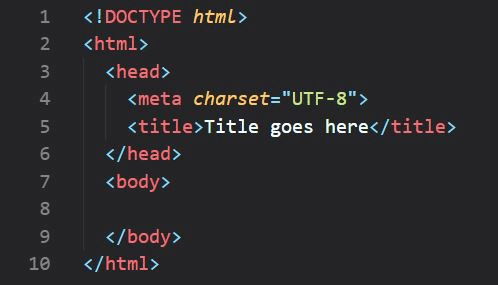
It might not make sense to you right now, but once you take an HTML course, you’ll start to get it soon enough.
As you learn and understand the required structure of HTML, you’ll be able to recall HTML shortcuts in no time.
In the above example, you can see that the code is written for an HTML page, including a header, title, and body. The tags within the brackets begin to give the document structure, while the actual content can be added in between them.
Collectively, the tags and content are considered an element. The first step in understanding HTML is learning all the most commonly used tags and what they do.
For example, the <p> tag denotes a paragraph. Add <p> to start a new paragraph and then begin typing your content like this:

All opening tags will need a closing tag that matches. You can write closing tags with a backslash before the tag. For instance, to end a paragraph, you would include </p> after the content.
That is just an example of one tag. There are hundreds of other tags that can help you make more dynamic projects. The order and way you put tags together are how the structure and style of your webpage or asset will come to life.
Some of the most popular tags include:
<H1>– first header text size<b>– bolding the text<i>– italicizing the text<a href=>– adding a link to the document<font size="+3">– increasing the font to a specific size
Once you begin your study of HTML, these tags will become second nature to you. You’ll be able to recall exactly which one you need without having to look them up.
That is how programmers move so fast when writing code. They know the tags and how to fit them together to create the dynamic HTML-coded asset in their minds.
You might be thinking, “Couldn’t I just hire someone to code my website for me?” And while the answer is yes, there are still so many reasons you should learn HTML.
Let’s take a look at a few of the most important reasons why learning HTML is a valuable investment of your time.
Why You Should Learn HTML
To put it simply: HTML is the foundation for most of the sites you interact with every day. Even this very webpage is an HTML document.
It is so prevalent across the web that it makes sense for you to know, at least, the very basics of the HTML structure. You never know when it may come in handy.
Knowing it will help you become an even more savvy business person, marketer, product developer, and designer.
There are so many things you can do when you understand HTML. A solid foundation of HTML will set you apart from other founders, employees, and competitors from creating to editing.
By understanding basic HTML, you’ll be able to:
- Build custom sites that you code yourself
- Host assets on sites
- Inspect sites and know how they are built
- Code other assets, including basic software, apps, and more
- Administer site edits without the need for a developer
Deciding to learn HTML can even pay off in the long run as HTML’s usage continues to grow.
For example, take a look at this graph to see how HTML usage has increased over the years, while XHTML, an older markup language, has decreased:

With a solid understanding of HTML, you can position yourself as a competitive candidate for almost any position. You can use these skills to improve your business if you’re an entrepreneur yourself.
Who Needs To Learn HTML?
If you’ve found yourself on this page, you’re likely an excellent candidate to learn HTML— and also someone who will benefit from it.
Before you get hesitant, know that your age and skill level do not matter. Everyone from the founder to the intern will benefit from learning HTML.
Not many people have experience with HTML, so it’s okay to be starting from scratch. Embrace the excitement of learning something new and let your curiosity soar.
If you know HTML, a new world opens up to you. You can bring your ideas to life by creating responsive websites, applications, and more.
HTML will help people in a variety of job functions:
- Marketers – to know how to make changes to a website
- Product Development – to code interactive renderings of a product
- Customer Service – to aid in the lookup of orders and code custom messages
- Designers – to host their creations on the web and understand how they will be portrayed
- Salesperson – to automate prospect data filters, initiate cold emails, etc.
- Founders – to make edits to their product or site and share their vision for HTML-enriched assets in a more concrete way
As you can see, there are many benefits associated with learning HTML, and the knowledge can impact multiple different business units.
Are you looking to change your day-to-day work? Consider learning HTML as a new skill that you can offer your company.
There are plenty of jobs that you can get when you understand HTML.
What Jobs Can You Get by Learning HTML?
You can make yourself uniquely valuable to almost any organization by learning HTML.
Let’s face it: having someone on staff who can put out fires on your website is always a need for any organization.
You won’t become a software developer overnight, but learning HTML will put you on the right path to become one.
HTML coding knowledge is a specialized skill that is in demand by employers all around the world. A software developer is one of the most common jobs that will use HTML.
The need for software developers has constantly grown over the past few years. It is estimated that there will be 28.7 million software developers needed by the year 2024:
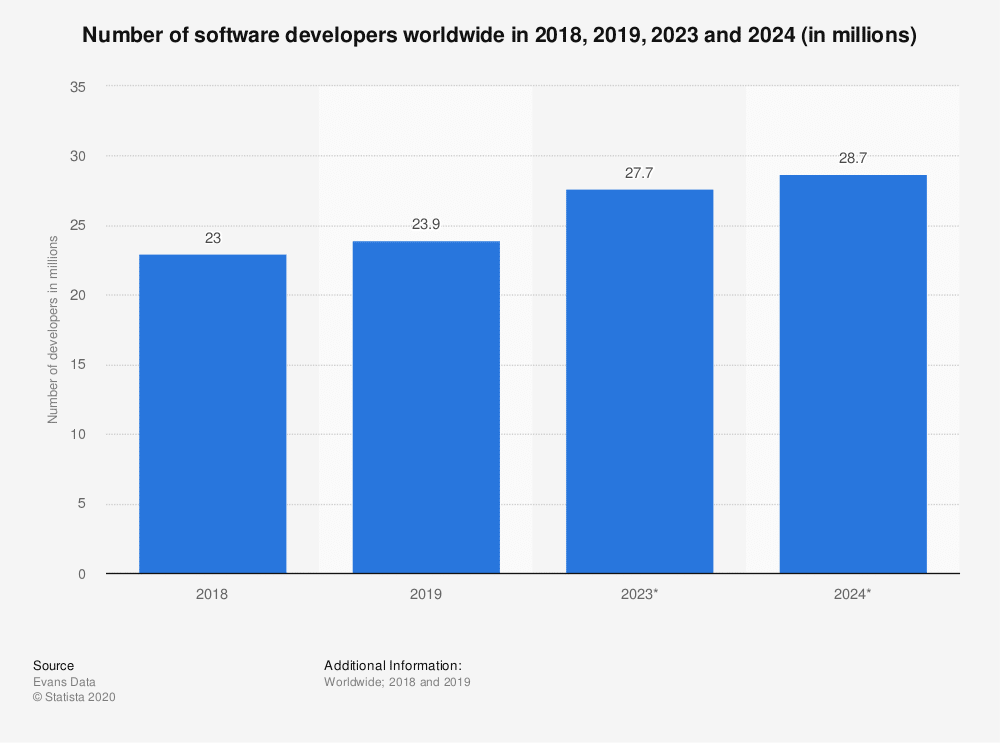
There are so many different software developers that you can become if you learn HTML. With an HTML skillset, you can get the following jobs:
- Frontend Developer – codes the part of the website that the user interacts with
- Backend Developer – codes the content management system (CMS) that the content manager inputs assets into so they appear on the frontend
- Full Stack Developer – codes both the frontend and the backend of the website
Not interested in being a web developer? Don’t worry. There are plenty of other jobs that will benefit from your HTML knowledge.
HTML knowledge will make you an all-around more marketable job prospect. You’ll naturally find different ways to use your skills in various departments at your company.
Even just a light foundational knowledge of HTML can be an asset to any company. You’ll know what people are talking about and how to explain technical ideas to team members.
Marketing, business intelligence, and product development all can benefit from HTML. Here are some of the jobs you can get within each of those disciplines:
- Email Marketing Manager – you can create HTML-enriched emails that are more visually engaging for the end-recipient
- Marketing Operations Manager – HTML is often needed to add integrations to ensure the secure passing of customer data
- Data Science/SQL Administrator – you can run HTML scripts to synthesize large amounts of data and models
- Business Intelligence Manager – you can use HTML modules to unearth trends and insights in your customer data
- Product Manager – you can use HTML to build, test, and code new products
If these jobs sound interesting, you should consider taking the time to learn HTML. But make no mistake: learning HTML can be a challenging task.
It might not be something that you understand right away. Instead, you might have to work at it to ensure you know every component of the new language you’re learning.
But just exactly how hard is it to develop a decent understanding of HTML? Let’s take a look and see what new students should expect.
How Hard Is It to Learn HTML?
Learning HTML will take practice, practice, and some more practice, just like any new skill.
Your approach to HTML should be like your approach to learning a new language. Start with the understanding that you are beginning with no prior knowledge. It can be humbling for even the most experienced workers.
However, once you realize that you don’t know anything about this new language, you can begin to dive in and discover what it is really about.
As you learn, HTML will become more apparent to you, and you can continue to chip away at each lesson which will compound on one another.
Soon, you’ll be able to put together complex elements and make visually-stunning HTML pages and applications.
How Long Does It Take to Learn HTML?
The process can take a while. If it were easy, everyone would understand HTML.
It is truly a specialized skill that you need to take the time to learn to ensure you comprehend everything slowly.
There are abbreviated courses that can teach you the basics of HTML in just a few days or a month. However, you won’t be a software developer overnight.
A thorough understanding of HTML can take months or years to know everything you need to know about it.
Wondering how to get started? Let’s take a look at the best way to learn HTML.
The Best Way to Learn HTML
The best way to learn HTML is with guided practice. It can be in a boot camp (in-person or online) or with guided modules.
A module provides a mix of video instruction, lectures, and guided practice. Some even have a test that you take at the end of each lesson.
Modules are practical because they enable students to learn at their own pace and take a hands-on approach to the lesson.
Here is an example of a module in action:
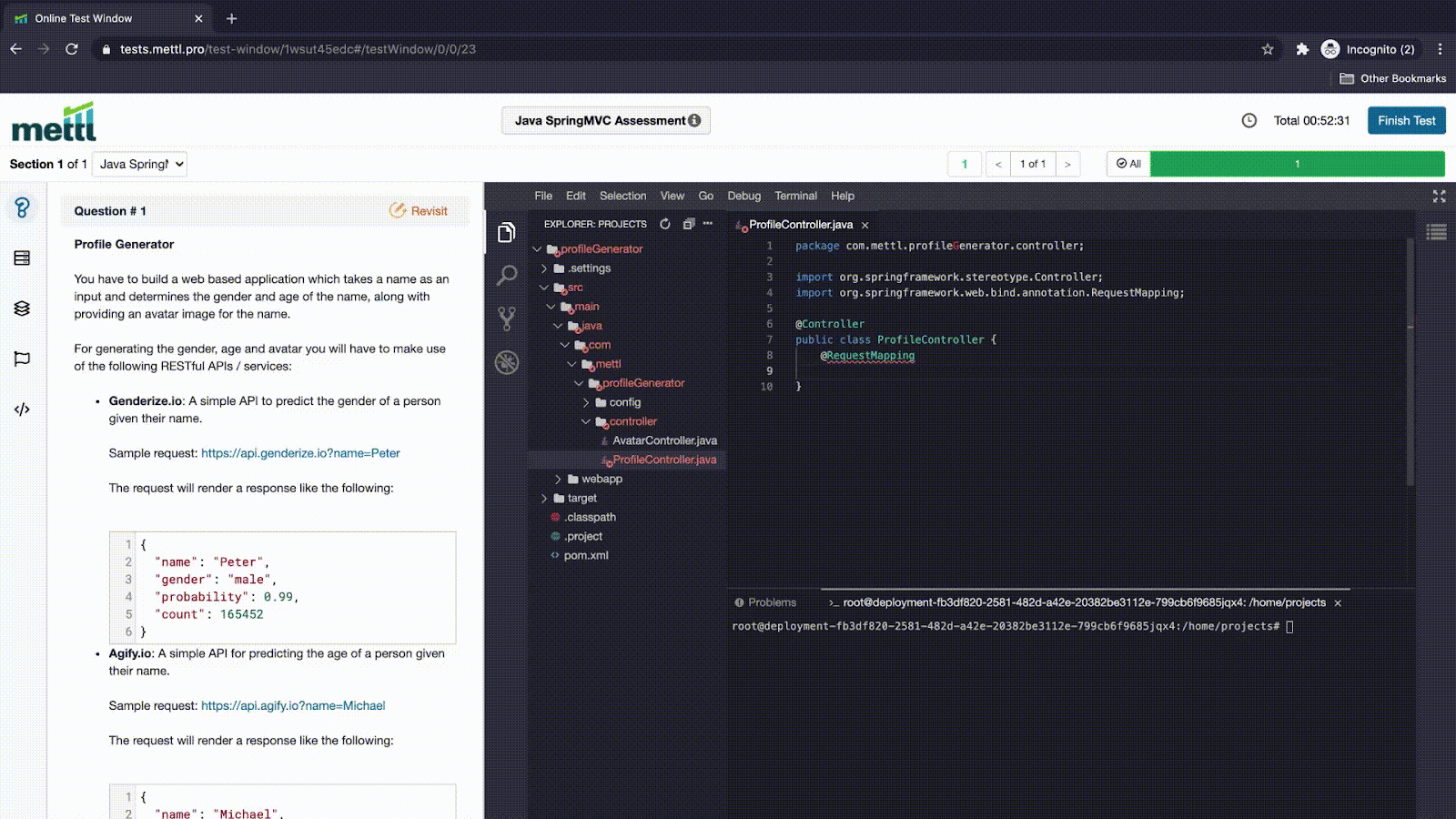
Ideally, you’d log into a module, learn a specific lesson about HTML, and then do a practice assignment to test your newly developed skills.
The lessons should build on each other over time.
You want to be sure that the medium you’re learning from offers application questions to test your skills along the way.
It’ll help you understand the concepts and language that you’re learning.
Now that you know how and why you should learn HTML, let’s take a look at some of the best HTML programs that you can use for free.
How to Learn HTML for Free
The most critical first step in your HTML education journey is selecting the right program that works for you.
There are so many different programs on the market. You should find the one that fits your learning style and commit to it.
Below, we’ve outlined some of the best free HTML resources you can use in your study.
Codecademy

Codecademy has numerous free programs to provide you with the technical skills you need. Over 50 million students have used Codecademy to learn basic HTML and coding.
The company believes it has “perfected” how students learn to code. The program involves three distinct pillars: learn by doing, get instant feedback, and put your learning into practice. These will shape how you discover HTML with a hands-on, guided approach.
The company even offers forums, chats, chapters, and events to get added assistance during your educational journey. You can chat in real-time through their interface or post a question on the online forum.
If you meet like-minded people virtually, you can even get acquainted with them at a Codecademy-sanctioned event. By pairing community with hands-on learning, Codecademy sets itself apart from the others.
Learn-HTML.org
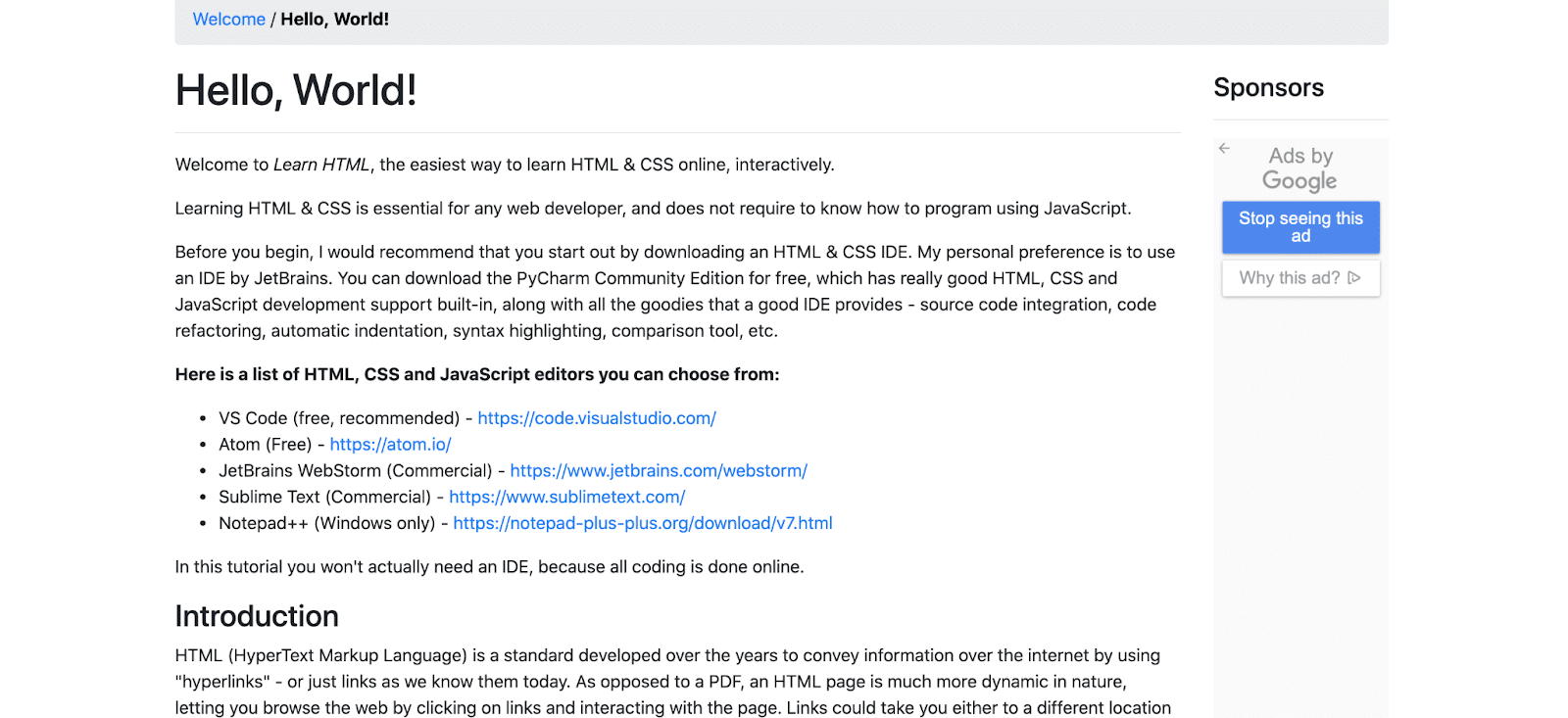
Learn-HTML.org is a reliable source for everything you need to know about HTML. There is plenty to dive into on Learn-HTML.org, a free online module course that will take you step-by-step into the world of coding.
The site offers tutorials for HTML beginners that show them how to build HTML and CSS sites from scratch. The tutorials start with the basics and become more intense and complex as the lessons continue.
Lessons include everything ranging from essential elements, links, images, buttons, navigation bars, forms, video, responsive web design, app cache, local storage, drag-and-drop, and more.
This website is an excellent resource if you need additional help on a specific element on your site. You can easily find the tutorial and get valuable information for that particular widget you want to build.
General Assembly Dash
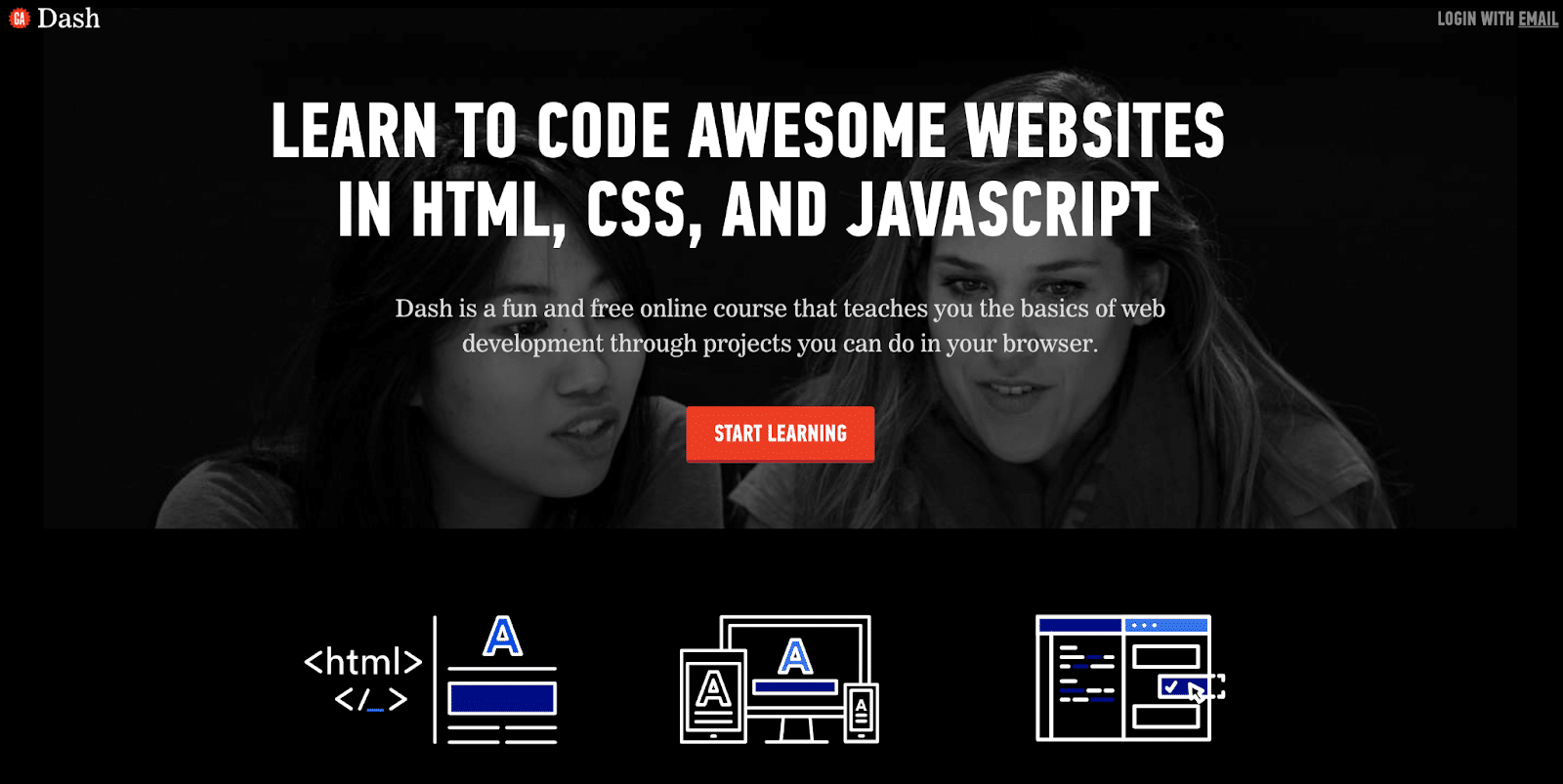
General Assembly Dash is a popular site to begin to learn the basics of HTML. This free online course leverages projects to help you understand HTML concepts.
The program is excellent for beginners who want a foundational overview of HTML or intermediates who need a refresher course.
Within the same course, you’ll learn HTML5, CSS3, and Javascript as well. It’ll enable you to make stunning websites with multiple layouts and user events.
You can continue your education beyond this introductory course with General Assembly. The company offers a wide array of educational classes and resources to get more granular with HTML and other related topics of interest.
MIT OpenCourseware

MIT offers open courseware classes to enterprising students that want to learn from the leading technical university in the country. These courses are designed by notable faculty and students who contribute to the content online.
The format of these courses is similar to miniature online college courses. You’ll be able to watch video lectures, view lecture notes, complete assignments and projects, review transcripts, and take an exam to test your skills.
Once completed, you can review the solutions and see how you performed. It’s an excellent resource to complement your HTML studies. Like the content taught in Universities and paid courses, the content is made free for students.
What You Should Learn With HTML
Once you learn HTML, your web development education doesn’t stop. There is plenty more to learn to enhance your HTML knowledge and make it more useful.
Two other languages that you should also learn include CSS and Javascript.
CSS (or cascading sliding sheets) is a programming language that focuses more on your document’s style rather than its bare structure, as HTML does.
Together, knowledge of CSS and HTML can make you a skilled developer.
Javascript is another programming language you should learn to further your skills. It’s a programming language that enables you to make dynamic content. You can animate images or make different multimedia elements fly across the screen.
Javascript will make any website more engaging for the end-user and potentially increase their time on your site.
Summary
Learning HTML can feel like an undertaking. You need to understand the basics of what you’re trying to accomplish and find the right program that meets your needs.
Often, it can feel like you’re learning an entirely new language. That’s why it is so critical to take your time to make the proper investment in the right program.
Thankfully, many free options on the market can help make you into an HTML professional through lessons, tutorials, and guided modules. No matter which you choose, you’ll be on your way to unlocking the secrets of HTML in no time.
Done with learning HTML? It’s just the beginning of your web development journey. Progress further by reading our post on the best programming languages to learn.



Leave a Reply